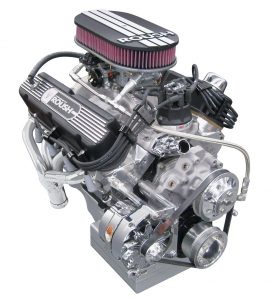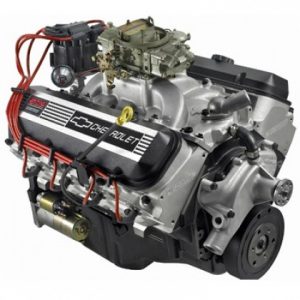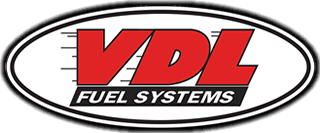
ATTENTION ALL CRATE RACERS:
A crate engine is a race engine. The advent of crate racing was intended to offer a lower-cost alternative and to open the ranks of participants; but the industry has lost sight of the fact that it is still a high performance engine and needs to be treated as such. The horsepower range is 350-450; the compression is typically 9.5:1, and the top rpm can be 6800. With those parameters, the crate engine requires the proper ignition system, the correct spark plug and gap, a good leaded race fuel and regulated fuel system, and a properly designed carburetor with the correct settings. VDL Fuel Systems’ Holley 80541 / 650 HP (or Holley 80528 / 750 HP for the 604 crate with open rules) or the Holley 4412 or 7448 for 2 barrel classes is the carburetor you are looking for; but, it will only perform to its potential if the parameters listed above are correct. All carburetors are reactive, and not proactive, in their function and must be fed the correct “information” to perform well. So, we would like to offer the following guidance to all crate racers to get the most out of your crate engine and carburetor:
IGNITION
Lock out the distributor. This will remove the advanced curve to get full timing through the entire rpm band of your engine from idle to wide open. Your restarts and off-the-corner throttle response will be crispier!
TIMING
The ideal timing for the crate engine is 36 degrees. However; if you are running pump gas, you may need to lower the timing to avoid detonation and you will lose horsepower and torque.
SPARK PLUGS
We are finding that most crate engines are leaving the factory with a resistor plug installed or at least a spark plug from a heat range that is too hot. The Champion plug number for the crate is S61YC. We are most familiar with Champion’s number system after 5 years as a race engineer with them, but you can certainly cross reference that number to your favorite brand – Autolite AR94, NGK R5724-8. There is no performance gain or loss from brand to brand because all the plug needs to do is generate a spark to light the fuel.
Gap your plugs on .035, not .045 as suggested on most valve covers. There is no performance advantage to wider gaps and they can cause a misfire or stumble.
 FUEL SELECTION
FUEL SELECTION
A crate engine is a race engine and must be fed the proper octane. DO NOT run pump gas or any mixture involving it. Pump gas is not reliable or consistent from batch to batch, pump to pump, season to season. And, the additives in it that are necessary to get it to burn are corrosive and will eventually eat the glue out of the power valves, deteriorate the gaskets, break down the foam in the fuel cell, rust steel parts in the engine, etc. With 9.5 : 1 compression, crate engines need a good leaded 110 octane race fuel.
We will not make a jetting recommendation for the use of pump gas due to the inconsistency and instability of the blend.
Oxygenated fuels are certainly available and can give more horsepower if the carburetor is jetted correctly on an engine dyno. If not, the benefits will be lost. Oxygenated fuels must also be stored in a cool environment in a sealed non-transparent container. If not, the light ends will evaporate off and leave you with an unknown fuel. The use of oxygenated fuels must also be accompanied with a stringent maintenance program after every race weekend. If not, you will face the same corrosive issues as in the use of pump gas.
FUEL PRESSURE
Would you go to the track without an air pressure gauge? Then, don’t go without a fuel pressure gauge. 6-7 pounds of fuel pressure is the ideal range for your crate engine; BUT, be aware that a fuel pump designated as 6 pounds on the box may not pump 6 pounds because of all the variables involved in your specific engine: cam lobe for the pump, length of the pump arm, and the diaphragms and springs installed in the pump. A fuel pressure gauge installed on the dash is the only option in our opinion, and a simple bulkhead fuel pressure regulator installed between the fuel pump and the carburetor will make this a worry-free setup. The driver can see the gauge and will then be able to diagnose any issues by watching the movement of the needle in relationship with the throttle input. Actually, the gauge needle should not move at all and should be rock solid like an oil pressure gauge from idle to wide open. A bouncing needle will indicate air in the fuel line due to vapor locking, a collapsed or split line, a loose fitting, bad placement of the pickup in the cell, etc. Movement of the needle between idle and wide open will also indicate a poorly-functioning pump or clogged fuel filter. So, install a gauge on the dash, set the regulator on 6.5 pounds, and eliminate the worry.
CARBURETOR
A properly designed carburetor will get the most horsepower out of your crate engine and will make restarts smoother and crisper. That is VDL’s forte: a custom built 650 HP or 750 HP or 4412 carburetor built specific for your crate engine and class of car. A DIRT Sportsman crate is not the same as an asphalt Pro Late Model crate; and a 602 crate is not the same as a 603 or 604 or 525 or 347. We are ready to build the carburetor you need, just for you, one at a time.

